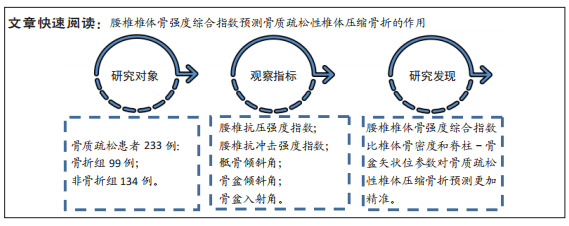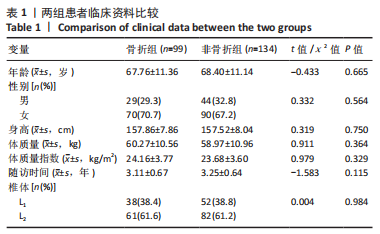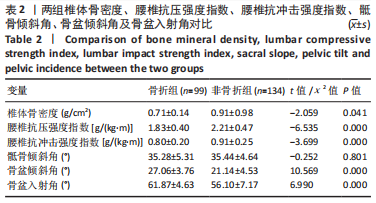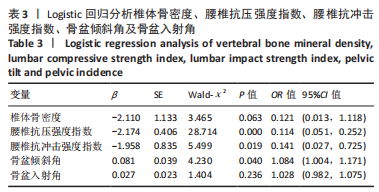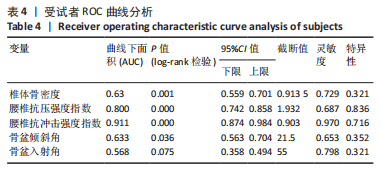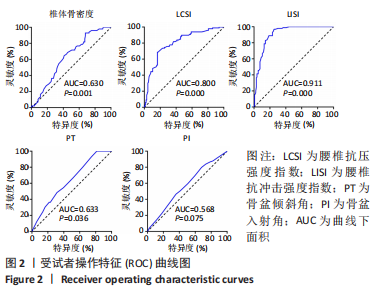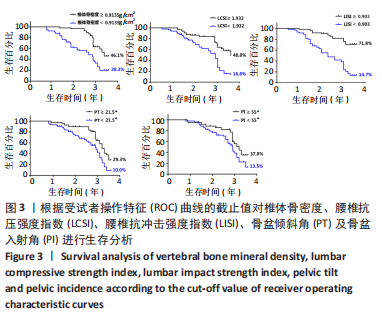[1] LEBOFF MS, GREENSPAN SL, INSOGNA KL, et al. The clinician’s guide to prevention and treatment of osteoporosis. Osteoporos Int. 2022;33(10):2049-2102.
[2] WAKIM J, RAJAN T, BESCHLOSS A, et al. Etiologies, incidence, and demographics of lumbar vertebral fractures in U.S. emergency departments. J Spine Surg. 2022;8(1):21-28.
[3] 中国康复医学会骨质疏松预防与康复专业委员会. 骨质疏松性椎体压缩骨折诊治专家共识(2021版)[J]. 中华医学杂志,2021,101(41):3371-3379.
[4] Schousboe JT. Epidemiology of Vertebral Fractures. J Clin Densitom. 2016;19(1):8-22.
[5] CAMACHO JE, USMANI MF, STRICKLAND AR, et al. The use of minimally invasive surgery in spine trauma: a review of concepts. J Spine Surg. 2019;5(Suppl 1):S91-S100.
[6] DONG Y, PENG R, KANG H, et al. Global incidence, prevalence, and disability of vertebral fractures: a systematic analysis of the global burden of disease study 2019. Spine J. 2022;22(5):857-868.
[7] WANG L, YU W, YIN X, et al. Prevalence of Osteoporosis and Fracture in China: The China Osteoporosis Prevalence Study. JAMA Netw Open. 2021;4(8):e2121106.
[8] KARLSSON MK, KHERAD M, HASSERIUS R, et al. Characteristics of Prevalent Vertebral Fractures Predict New Fractures in Elderly Men. J Bone Joint Surg Am. 2016;98(5):379-385.
[9] CASEZ P, UEBELHART B, GASPOZ JM, et al. Targeted education improves the very low recognition of vertebral fractures and osteoporosis management by general internists. Osteoporos Int.2006;17(7): 965-970.
[10] KENDLER DL, BAUER DC, DAVISON KS, et al. Vertebral Fractures: Clinical Importance and Management. Am J Med. 2016;129(2):221.
[11] ZILELI M, FORNARI M, COSTA F, et al. Epidemiology, natural course, and preventive measures of osteoporotic vertebral fractures: WFNS Spine Committee Recommendations. J Neurosurg Sci. 2022;66(4):282-290.
[12] JI C, RONG Y, WANG J, et al. Risk Factors for Refracture following Primary Osteoporotic Vertebral Compression Fractures. Pain Physician. 2021;24(3):E335-E340.
[13] LEMS WF, PACCOU J, ZHANG J, et al. Vertebral fracture: epidemiology, impact and use of DXA vertebral fracture assessment in fracture liaison services. Osteoporos Int. 2021;32(3):399-411.
[14] LI Q, LONG X, WANG Y, et al. Development and validation of a nomogram for predicting the probability of new vertebral compression fractures after vertebral augmentation of osteoporotic vertebral compression fractures. BMC Musculoskelet Disord. 2021;22(1):957.
[15] ROBINSON WA, CARLSON BC, POPPENDECK H, et al. Osteoporosis-related Vertebral Fragility Fractures: A Review and Analysis of the American Orthopaedic Association’s Own the Bone Database. Spine (Phila Pa 1976). 2020;45(8):E430-E438.
[16] LENTLE B, KOROMANI F, BROWN JP, et al. The Radiology of Osteoporotic Vertebral Fractures Revisited. J Bone Miner Res. 2019;34(3):409-418.
[17] BAEK SW, KIM C, CHANG H. The relationship between the spinopelvic balance and the incidence of adjacent vertebral fractures following percutaneous vertebroplasty.Osteoporos Int. 2015;26(5):1507-1513.
[18] 张子龙,井齐明,乔瑞,等. 骨质疏松性椎体压缩骨折经皮椎体成形术后邻近椎体新发骨折的危险因素分析[J]. 中国修复重建外科杂志,2021,35(1):20-25.
[19] CAULEY JA, HOCHBERG MC, LUI LY, et al. Long-term risk of incident vertebral fractures. JAMA. 2007;298(23):2761-2767.
[20] JOISH VN, BRIXNER DI. Back pain and productivity: measuring worker productivity from an employer’s perspective. J Pain Palliat Care Pharmacother. 2004;18(2):79-85.
[21] VAN DER KLIFT M, DE LAET CE, MCCLOSKEY EV, et al. Risk factors for incident vertebral fractures in men and women: the Rotterdam Study. J Bone Miner Res. 2004; 19(7):1172-1180.
[22] 林顺鑫,江晓兵,沈耿杨,等.多发骨质疏松椎体压缩骨折的相关因素研究[J]. 中国骨伤,2016,29(9):836-840.
[23] KAPTOGE S, ARMBRECHT G, FELSENBERG D, et al. Whom to treat? The contribution of vertebral X-rays to risk-based algorithms for fracture prediction. Results from the European Prospective Osteoporosis Study. Osteoporos Int. 2006;17(9):1369-1381.
[24] KARLAMANGLA AS, BARRETT-CONNOR E, YOUNG J, et al. Hip fracture risk assessment using composite indices of femoral neck strength: the Rancho Bernardo study. Osteoporos Int. 2004;15(1):62-70.
[25] LIN T, YANG P, CAI K, et al. [Predictive effect of femoral neck strength composite indexes on femoral head collapse in non-traumatic osteonecrosis of femoral head]. Zhongguo Xiu Fu Chong Jian Wai Ke Za Zhi. 2021;35(8):967-972.
[26] LIN T, CAI K, YANG P, et al. Composite indices of femoral neck strength predicts the collapse of steroid-associated osteonecrosis of the femoral head: a retrospective study. BMC Musculoskelet Disord. 2022;23(1):722.
[27] XU Y, WU Q. Decreasing trend of bone mineral density in US multiethnic population: analysis of continuous NHANES 2005-2014. Osteoporos Int. 2018;29(11):2437-2446.
[28] RUD B, VESTERGAARD A, HYLDSTRUP L. Accuracy of densitometric vertebral fracture assessment when performed by DXA technicians--a cross-sectional, multiobserver study. Osteoporos Int. 2016;27(4):1451-1458.
[29] 张顺聪,莫国业,袁凯,等. 脊柱骨盆参数与椎体成形术后邻近节段新发骨折的关系[J].中国矫形外科杂志,2017,25(18):1642-1646.
[30] SCHUIT SC, VAN DER KLIFT M, WEEL AE, et al. Fracture incidence and association with bone mineral density in elderly men and women: the Rotterdam Study. Bone. 2004; 34(1):195-202.
[31] OBEID I, HAUGER O, AUNOBLE S, et al. Global analysis of sagittal spinal alignment in major deformities: correlation between lack of lumbar lordosis and flexion of the knee. Eur Spine J. 2011;20 Suppl 5(Suppl 5):681-685.
[32] DEBARGE R, DEMEY G, ROUSSOULY P. Sagittal balance analysis after pedicle subtraction osteotomy in ankylosing spondylitis. Eur Spine J. 2011;20 Suppl 5(Suppl 5):619-625.
[33] 马泓,吕国华. 腰椎滑脱患者脊柱-骨盆参数改变的研究进展[J].中国脊柱脊髓杂志,2014,24(3):271-274.
[34] DAVY SW, BERGIN D. Opportunistic diagnosis of osteoporotic vertebral fractures on standard imaging performed for alternative indications. BJR Open. 2021;3(1):20210053.
[35] XU M, MOTOMURA G, IKEMURA S, et al. Proximal femoral morphology after transtrochanteric posterior rotational osteotomy for osteonecrosis of the femoral head: A three-dimensional simulation study. Orthop Traumatol Surg Res. 2020;106(8): 1569-1574.
[36] FINIANOS B, ZUNQUIN G, EL HAGE R.Composite Indices of Femoral Neck Strength in Middle-Aged Inactive Subjects Vs Former Football Players. J Clin Densitom. 2021; 24(2):214-224.
|
